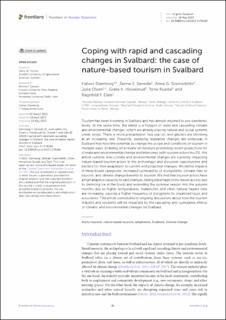| dc.contributor.author | Dannevig, Halvor | |
| dc.contributor.author | Søreide, Janne | |
| dc.contributor.author | Sveinsdóttir, Anna Guðbjört | |
| dc.contributor.author | Olsen, Julia | |
| dc.contributor.author | Hovelsrud, Grete Kaare | |
| dc.contributor.author | Rusdal, Tone | |
| dc.contributor.author | Dale, Ragnhild Freng | |
| dc.date.accessioned | 2023-10-04T13:52:57Z | |
| dc.date.available | 2023-10-04T13:52:57Z | |
| dc.date.created | 2023-05-26T09:31:52Z | |
| dc.date.issued | 2023 | |
| dc.identifier.citation | Dannevig, H., Søreide, J. E., Sveinsdóttir, A. G., Olsen, J., Hovelsrud, G. K., Rusdal, T., & Dale, R. F. (2023). Coping with rapid and cascading changes in Svalbard: the case of nature-based tourism in Svalbard. Frontiers in Human Dynamics, 5, Article 1178264. doi: | en_US |
| dc.identifier.issn | 2673-2726 | |
| dc.identifier.uri | https://hdl.handle.net/11250/3094192 | |
| dc.description.abstract | Tourism has been booming in Svalbard and has almost returned to pre-pandemic levels. At the same time, the island is a hotspot of rapid and cascading climate and environmental changes, which are already placing natural and social systems under stress. There is more precipitation, less sea ice, and glaciers are shrinking at an increasing rate. Presently, sweeping legislative changes are underway in Svalbard that hold the potential to change the scope and conditions of tourism in multiple ways. Drawing on a review of literature presenting recent projections for climate and environmental change and interviews with tourism actors (n=25), this article outlines how climate and environmental changes are currently impacting nature-based tourism actors in the archipelago and discusses opportunities and barriers for their adaptation to current and projected changes. We define impacts in three broad categories: increased vulnerability of ecosystems; climate risks to tourism; and climate change benefits to tourism. We find that tourism actors have a high adaptive capacity to said changes, taking advantage of increased access due to shrinking ice in the fjords and extending the summer season into the autumn months due to higher temperatures. Avalanches and other natural hazard risks are increasing, causing a higher frequency of disruptions to organized tours and excursions. This article contributes to ongoing discussions about how the tourism industry and residents will be impacted by the cascading and cumulative effects of climatic and environmental changes on Svalbard. | en_US |
| dc.language.iso | eng | en_US |
| dc.publisher | Frontiers | en_US |
| dc.rights | Navngivelse 4.0 Internasjonal | * |
| dc.rights.uri | http://creativecommons.org/licenses/by/4.0/deed.no | * |
| dc.title | Coping with rapid and cascading changes in Svalbard : the case of nature-based tourism in Svalbard | en_US |
| dc.type | Peer reviewed | en_US |
| dc.type | Journal article | en_US |
| dc.description.version | publishedVersion | en_US |
| dc.rights.holder | © 2023 The Authors | en_US |
| dc.source.pagenumber | 16 | en_US |
| dc.source.volume | 5 | en_US |
| dc.source.journal | Frontiers in Human Dynamics | en_US |
| dc.identifier.doi | 10.3389/fhumd.2023.1178264 | |
| dc.identifier.cristin | 2149445 | |
| dc.relation.project | EC/H2020/869154 | en_US |
| dc.relation.project | The Research Council of Norway: 302914 | en_US |
| dc.source.articlenumber | 1178264 | en_US |

